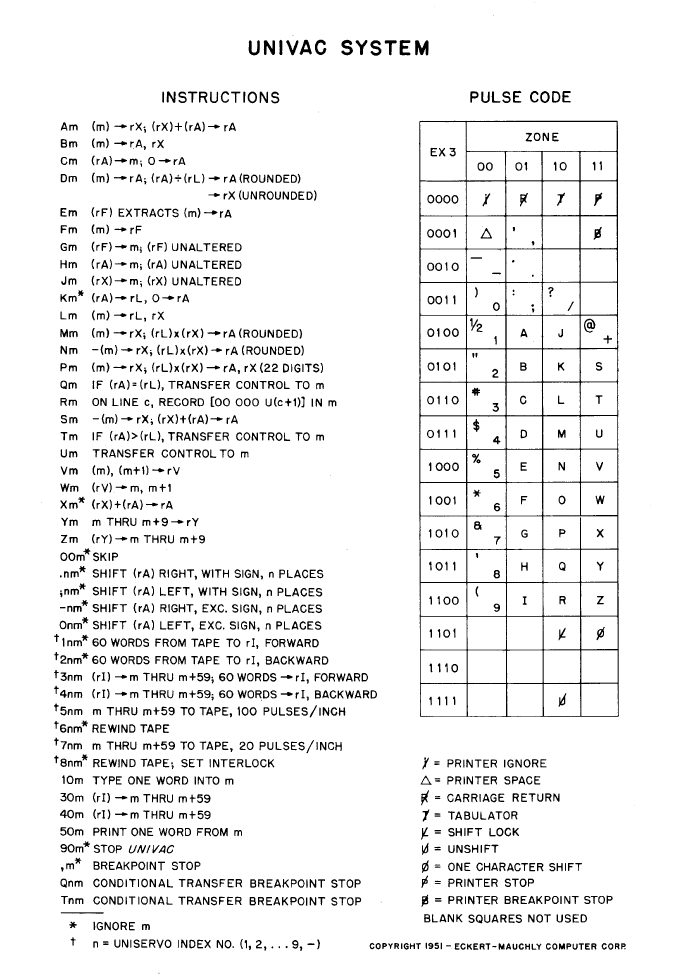Language peer sets for C-10:
United States↑
United States/1949↑
Designed 1949 ↑
1940s languages ↑
First generation↑
Immediate Post-War↑
Genus Initial orders ↑
Multi-purpose ↑
Initial orders↑
Assemblers↑
Fixed operation ↑
Initial orders/1949↑
Assemblers/1949↑
Fixed operation/1949↑
Initial orders/United States↑
Assemblers/United States↑
Fixed operation/United States↑
Multi-purpose ↑
Multi-purpose/1949↑
Multi-purpose/us ↑
C-10(ID:5442/c::011)
First Mnemonic codeset
alternate simple viewCountry: United States
Designed 1949
Genus: Initial orders
Sammet category: Multi-purpose
Holberton's instruction code for the BINAC, the first to use Mnemonic code.
It was said by Hopper to be "the basis for all subsequent programming languages" (She also said Holberton "was the best programmer" that she had ever known) Bergin 2000
from WTI:
"What are you most proud of?
The design of the instruction code of UNIVAC 1 and the code called C-10. I was in engineering in those days and I had just come from programming the ENIAC. That code was mostly designed at night while I was laying awake. My daughter said it was a form of psychology. I always stayed in the background and got most things done without people knowing that. I had to learn to speak out and it effects me today. We have sessions at the nursing home and I speak up and they all sit there."
From WP Obit:
"Late in life, Mrs. Holberton was credited for her efforts to make the language and equipment of programming user-friendly. After World War II, she created an instruction code, called C-10, that allowed for control of the new UNIVAC -- the first general-purpose computer -- by keyboarded commands rather than by dials and switches.
While engineers focused on the technology of computing, Mrs. Holberton lay awake nights thinking about human thought processes, she later told interviewers.
She came up with language using mnemonic characters that appealed to logic, such as "a" for add and "b" for bring. She designed control panels that put the numeric keypad next to the keyboard and persuaded engineers to replace the UNIVAC's black exterior with the gray-beige tone that came to be the universal color of computers."
Abbott (1995) "The C-10 Code simply listed the instruction set of for UNIVAC. It also contained a simplistic chart of the timing cycles of the UNIVAC (alpha, beta, gamma, and delta time). Gamma and delta was when the instructions were executed. Alpha and beta time took care of stepping from one instruction to the next instruction, and initializing the instruction execution process."
Wikipaedia lists Ida Rhodes as a co-creator
People:
Related languages
| ENIAC short code | → | C-10 | Influence | |
| C-10 | → | A-0 | Compiled to | |
| C-10 | → | ACOMCAS | Evolution of | |
| C-10 | → | ARITH-MATIC | Compiled to | |
| C-10 | → | B-0 | Compiled to | |
| C-10 | → | MATH-MATIC | Compiled to | |
| C-10 | → | SAP | Influence | |
| C-10 | → | X-1 | Evolution of |
References:
in [ACM] (1958) [ACM] CACM 1(07) July 1958
in [ACM] (1958) [ACM] CACM 1(07) July 1958
in [ACM] (1958) [ACM] CACM 1(07) July 1958
Resources
- WITI Interview 1997
-
Reference card from 1951

Search in: Google Google scholar World Cat Yahoo Overture DBLP Monash bib NZ IEEE ACM portal CiteSeer CSB ncstrl jstor Bookfinder